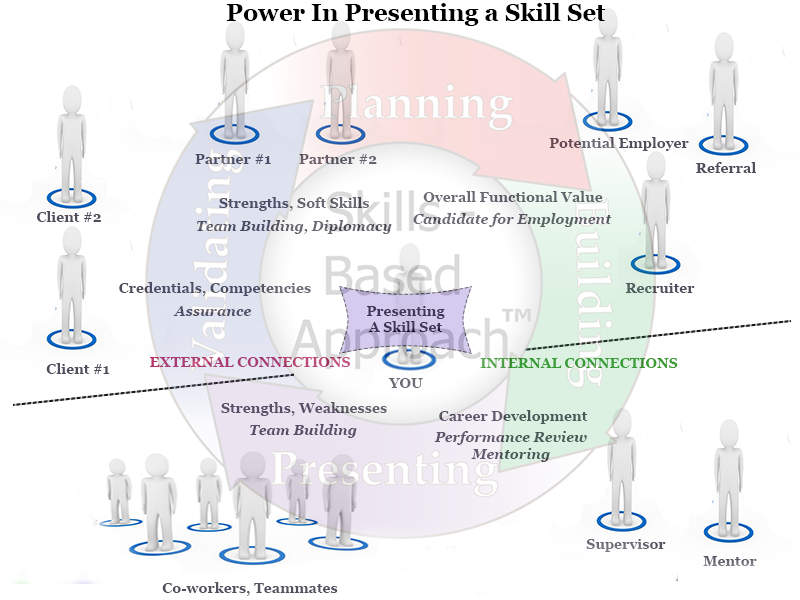There is benefit in presenting your skill set to not only recruiters and potential employers, but also an ‘internal network’ – co-workers and supervisors – and an ‘external network’ – partners and clients. As I talk about presenting a skill set, I want to clarify that there are many ways to present a skill- tagging, explaining, demonstrating, listing, and summarizing. (There is an in-depth description of them in A Skills Based Approach to Developing a Career.) Use your skill set to represent your functional capabilities to everyone in your target audience. Skills are universally defined (for the most part) and portable across platforms and their competencies are measurable.
It is advantageous to have your skill set accessible to your co-workers – what you ‘bring to the table’. The biggest benefit comes when you work on a team, where everyone knows the skill set of each member. Moreover, the level of expertise and validations of the skills are also known. This greatly improves the team’s productivity in three ways.
First, there is quick familiarity. Team members spend a few hours reviewing each other’s skill set so they have some idea of what each other’s contribution should be. Otherwise, without reviewing skill sets, it often takes weeks for teams to really get to know each other’s functional value.
Second, it is an accurate portrayal. Skill assessments and validations that accompany the presentation of a skill set properly portray skill competencies. Unfortunately, the way teams function today is often ‘trial and error’.
Third, it can help teams become more horizontal. An awareness of each other’s skill sets removes communication barriers, so members feel on more equal status. There is less need for ‘formal leadership’ or direction.
To present your skill set to co-workers, you should keep your skill set current in your LinkedIn profile and utilize a personal website. I suggest a personal website because it gives you more flexibility to share your skill set in different ways.
There is a lot of talk about the best way to conduct ‘performance reviews’ or ‘performance coaching’ or ‘mentoring’. Whatever the case, it should be a conversation based on your skill set and in the context of a Skill-Based Approach. Present your skill set to supervisors and talk about the fifteen to twenty skills on your personal website and/or LinkedIn profile (and soft skills that may not be included).
Talk about your short and long terms objectives since you started working. How are the objectives materializing? Are you satisfied in your current position?
Discuss your progress in building the skills over the prior period. What projects did you work on? How are your soft skills with coworkers and clients? How did you perform on assessments?
Collaborate on a short-term plan for the upcoming year. Base it on the development of a skill set. What company resources do you need to build skills (i.e. training or online courses)?
Brainstorm on the validation of skills in the long-term. Are you going to need accreditation to move up in the company?
Presenting your skill set to your external network – clients and partners – can be useful in your current position. Clients love to be reassured. Perhaps your company sold them on a product or service, but now it is time to sell them on you as you deliver on your company’s promise. Sharing your skill set with competencies goes a long way in convincing them you can do the work. Partners are an extension of your team. So, there are the same team benefits mentioned above. However, the difference when you work with partners is that you are usually the ambassador for your company – so include soft skills as part of your skill set.
